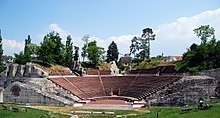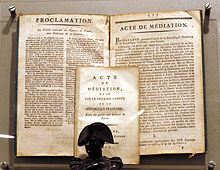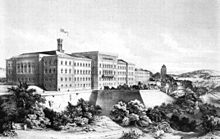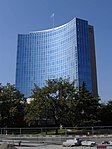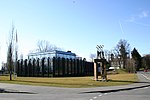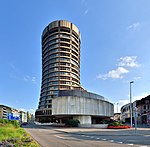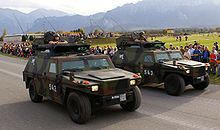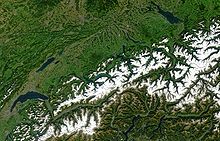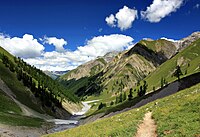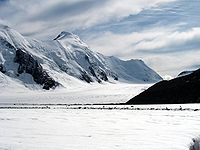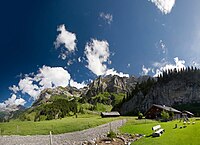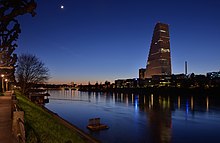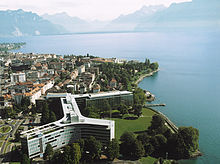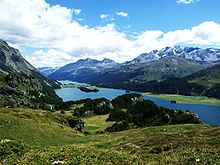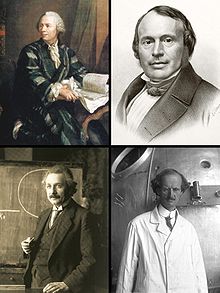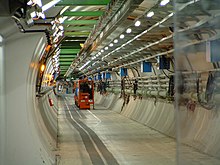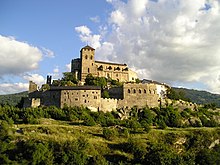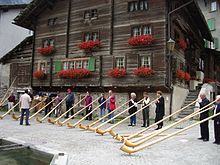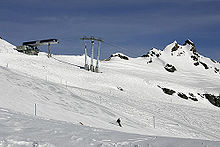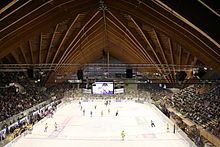Swiss
Switzerland (German Schweiz; French Suisse; Italian Svizzera; Romansh, Svizra), officially the Swiss Confederation (in German, Schweizerische Eidgenossenschaft; in Italian, Confederazione Svizzera; in French, Confédération suisse; and Romansh, Confederaziun svizra), is a landlocked country in central Europe with a population of 8,670,000 inhabitants (2018). Switzerland is a federal state with 26 states, called cantons, and has four official languages: German, French, Italian, and Romansh. Bern is called a federal city (not capital) and is the seat of federal authorities, while the country's private sector is most developed in the cities of Zurich, Basel and Geneva. Switzerland is the fourth richest country in the world, according to its GDP per capita, at US$83,718 (2011).
It is bordered by Germany to the north, France to the west, Italy to the south, and Austria and Liechtenstein to the east. It is diplomatically characterized by its neutral foreign relations policy, without having actively participated in any international conflict since 1815. Switzerland is the headquarters of numerous international organizations, such as the Red Cross, the World Trade Organization, the Universal Postal Union, the International Union of Telecommunications, the World Organization of the Scout Movement, as well as one of the two UN offices in Europe and specialized agencies of this institution such as the International Labor Organization or the World Health Organization. In turn, it is the headquarters of FIFA, the world's highest soccer body, and UEFA, the largest European soccer body; It is also the headquarters of the IOC, the highest body in charge of holding the Olympic Games and of FIDE, the highest chess body in the world; in synchrony with the previous entities, it houses the Court of Arbitration for Sport. The date of its creation as a State was set on August 1, 1291 in accordance with tradition. Due to this reason, every year the national holiday is celebrated on August 1st.
Switzerland is one of the most developed countries in the world. Due to its policy of neutrality, the country is home to a large number of immigrants from nations from various continents, which is why it is considered one of the European countries with the greatest cultural diversity. Switzerland is internationally known for its mountain tourism and for its watches, chocolates, knives, banks, railways and cheeses. Zurich, Geneva and Basel have been ranked among the top ten cities in the world in terms of quality of life.
Etymology
The name Suiza (previously spelled "Suiça") comes from Schwyz, the name of one of the cantons of Waldstätten that formed the nucleus of the Old Swiss Confederacy. The canton's place name dates from the year 972 and perhaps comes from the old high German Suittes, cognate with the verb swedan meaning "to burn, scorch" (cognate to Icelandic svíða, Danish and Swedish svide "chamuscar"), referring to the slash and burn by which a wooded area is burned to build some houses in the area (artiga). The use of the name for this area was extended to refer to the entire canton, and after the Swabian War in 1499 it was gradually used to name the entire confederation. The German name of Switzerland for the country, Schwiiz, is homonymous to that of the canton and its capital, so to distinguish it, a specific article is used in d'Schwiiz to refer to the country and the simple form Schwiiz for the canton and the city.
The country's former name, Helvetia, derives from the word Helvetii, a Celtic tribe that inhabited the Swiss plateau before Gallo-Roman times. The first mention of the name Helvetii dates from 300 BC. C. The names of the Neo-Latin "Confoederatio Helvetica" or "Helvetia" they were introduced when Switzerland became a federal state in 1848, dating back to the Helvetic Republic.
History
Early history
The oldest existing human remains date from approximately 150,000 years ago. Likewise, the oldest agricultural tools were found in Gächlingen and are estimated to date from 5300 BC. C.
The oldest known tribes in that area belong to the Hallstatt and La Tène cultures, named after the La Tène archaeological site, located north of Lake Neuchâtel. The La Tène culture flourished in the late Iron Age, around 450 BCE. C., possibly under the influence of the Greek and Etruscan civilizations. One of the most important ethnic groups in the region were the Helvetii. In 58 B.C. In 15 BC, Julius Caesar's forces defeated the Helvetii at the Battle of Bibracte. C., Tiberius, who would later be emperor of Rome, and Drusus the Greater conquered the Alps, integrating them into the growing Roman Empire. The region occupied by the Helvetii, from which the name Confoederatio Helvetica comes, became part of the Roman province of Gallia Belgica and later of the province of Germania Superior, while the eastern part of Switzerland modern was integrated into the Roman province of Recia.
In the Early Middle Ages, the western part of present-day Switzerland was part of the Kingdom of Burgundy from the 4th century. The Alemanni settled on the Swiss plateau in the V century and in the valleys of the Alps in the VIII, forming Alamania and leaving the current territory of Switzerland divided between the kingdoms of Burgundy and Alamania. In the VI, the entire region became part of the Frankish Empire after Clovis I's victory over the Alemanni at the Battle of Tolbiac (496). Later the Franks would also dominate the Burgundians.
Between the 6th and 8th centuries Switzerland continued under Frankish hegemony (the Merovingian and Carolingian dynasties). In 843, after reaching its maximum extent under the reign of Charlemagne, the Frankish empire was divided in the Treaty of Verdun. The territory of present-day Switzerland was divided between East Francia and Middle Francia until it was unified by the Holy Roman Empire. in the 11th century.
By 1200, the Swiss plateau belonged to the domains of the houses of Savoy, Zähringer, Habsburg and Kyburg. Some regions (Uri, Schwyz and Unterwalden, later collectively known as Waldstätten) were annexed as imperial enclaves to ensure empire control over the mountain passes. When the Kyburg dynasty fell in 1264, the Habsburgs extended their territories east of the Swiss plateau during the reign of Rudolf I, who became Holy Roman Emperor in 1273.
Former Swiss Confederation
The Old Swiss Confederacy was an alliance between the communities of the central valleys of the Alps. The Confederation facilitated the development of various common interests (free trade) and ensured peace on the main trade routes in the mountains. The Federal Charter of 1291, signed by the rural communities of Uri, Schwyz and Unterwalden, is considered the document that laid the foundation for the founding of the confederation, although it is likely that similar alliances had already existed decades earlier.
In 1353, the three original cantons had been united with the cantons of Glarus and Zug and with the city-states of Lucerne, Zurich and Bern to form the Old Confederation of eight cantons which existed until the end of the century XV. Territorial expansion helped increase the power and wealth of the Confederacy. By 1460, the Confederates controlled much of the land south and west of the Rhine River as far as the Alps. In 1499 Switzerland's victory over the Swabian League and the House of Habsburg in the Swabian War resulted in de facto independence from the Holy Roman Empire.
The Old Swiss Confederacy had acquired a reputation for invincibility during these wars, but the expansion of the Confederation suffered a setback in 1515, with defeat at the Battle of Marignano. This marked the end of the so-called "heroic" of Swiss history. The success of Hulrich Zwingli's Reformation in some cantons led to several internal wars in the country between 1529 and 1531, the Kappel Wars (Kappeler Kriege). As early as 1648, more than a century after these disputes, Johann Rudolf Wettstein, as an envoy of the Swiss Confederation, achieved through skilful negotiations that the signatory powers of the Treaty of Westphalia officially recognize Switzerland's independence from the Holy Roman Empire and their neutrality in wars (Ancien Régime).
The 16th and 17th centuries were characterized by the increasing authoritarianism of the ruling families. In 1653, this situation, combined with the financial crisis brought on by the Thirty Years' War, produced the outbreak of the Swiss Peasant War of 1653. Added to this, there remained the religious conflict between the Catholic cantons and the Protestant cantons, which among 1656 and 1712 led to violent clashes, such as the Battle of Villmergen.
Napoleonic era
In 1798, the forces of the French Revolution conquered Switzerland and imposed a new constitution. This constitution centralized government and abolished the cantons, and both the territory of Mulhouse and the Valtellina valley were separated from Switzerland. The new regime, known as the Helvetic Republic, was highly unpopular. It had been imposed by an invading army, destroying centuries of customs and traditions and turning Switzerland into a satellite state of France. The strong repression carried out by France during the Nidwalden rebellion (September 1798) was an example of the oppressive presence of the French army and of local resistance to the occupation.
Switzerland had to enter the continental blockade, which damaged and stimulated its industry at the same time, and had to supply troops. Initially 16,000 men, reduced to 12,000 in 1811, but despite the incentives offered and threats of conscription, the numbers never reached the required numbers.
When war broke out between France and its rivals, Russian and Austrian forces invaded Switzerland. The Swiss people refused to fight alongside the French in the name of the Helvetic Republic. In 1803 Napoleon arranged a meeting with Swiss political leaders in Paris; the result of this meeting was the document called the Act of Mediation, which largely restored the autonomy of Switzerland and the Confederation of 19 cantons. From then on, much of Swiss policy would be aimed at balancing the tradition of autonomous cantons. with the need for a central government.
In 1815, the Congress of Vienna fully restored Switzerland's independence, and the European powers agreed to permanently recognize the country's neutrality. Swiss troops served various foreign governments until 1860, when they fought at the siege of Gaeta. The treaty also increased the territorial extension of Switzerland, with the integration of the cantons of Valais, Neuchâtel and Geneva. The boundaries of Switzerland have not changed since then.
Federal state
The canton of Bern was one of the three cantons that presided over the Tagsatzung (former executive and legislative council) along with Lucerne and Zurich. The capital of the canton was chosen in 1848 as the seat of the federal authorities, mainly due to its proximity to the French-speaking part of the country.
The restoration of power was only temporary. After a period of unrest with repeated violent clashes, such as the Züriputsch in 1839, civil war broke out in 1847 when some of the Catholic cantons tried to establish an alliance among themselves (Sonderbund). The war lasted less than a month, causing fewer than a hundred casualties, most of which were due to friendly fire. The Sonderbund war seems very small compared to other conflicts that existed in Europe in the 19th century and in the history of its society.
The war showed the inhabitants the need for unity to strengthen themselves against their European neighbors. Swiss from all walks of life, whether Catholic, Protestant, Liberal or Conservative, realized that the cantons would do better if they combined their economic and religious interests.
So, while the rest of Europe was in the midst of revolutions and wars, the Swiss enacted a more modern constitution, which gave the government a federal design, largely modeled on the American model. This constitution imposed a central authority, leaving the cantons the right to self-govern and resolve local issues. In addition, the national assembly was divided into an upper house (the Swiss Council of States, with two representatives from each canton) and a lower house (the Swiss National Council, with elected representatives from all over the country). To introduce any change in the constitution, it became mandatory to hold a referendum.
A unique system of weights and measures was also introduced, and in 1850 the Swiss franc became the only official currency of the country. Article 11 of the constitution prohibited the sending of troops abroad, but made an exception for the Papal States, by not considering members of the papal army (Swiss Guard) mercenaries. In this sense, in 1860 the Swiss army was forced to participate alongside Francisco II of the Two Sicilies in the siege of Gaeta.
One of the most important clauses of the constitution was the one that stated that it could be completely rewritten if the occasion demanded, in this way the constitution would evolve totally instead of being modified year after year. It came in handy with the advent of the Industrial Revolution, when many proclaimed that it was time to change the constitution. A first draft was rejected by the population in 1872, but two years later the modifications were accepted. It was here that an optional referendum was introduced for the creation and modification of laws at the federal level. Norms regulating the army, commerce, and other legal issues were also established. Finally, in 1891, the constitution was revised again and an unusual system of direct democracy was introduced, which remains unique to this day.
Modern history
Switzerland was not invaded in either of the two world wars. During the First World War, Switzerland gave asylum to Vladimir Illych Ulyanov (Lenin) who remained there until 1917. In 1919 Switzerland's neutrality was seriously questioned by the scandal involving Robert Grimm and Arthur Hoffmann, when they tried to agree a truce between Russia and Germany. However, in 1920, Switzerland entered the League of Nations, which had its headquarters in Geneva, with the only condition that it would be free of all military requirements.
During World War II, the German army made detailed invasion plans (Operation Tannenbaum) but never invaded Switzerland. The country was able to maintain its independence through a combination of military deterrence, concessions to Germany, and very good Good luck in the military operations that delayed the German invasion. There were also attempts by the Swiss National Socialist Party to annex the country to Germany, but they failed. The Swiss press harshly criticized the Third Reich, frequently insulting its Führer. Switzerland was an important spy base for both sides during the conflict, as well as often acting as a mediator in communications between the Allied and Axis forces. The International Red Cross, based in Geneva, played a very important role during this and other conflicts.
Trade with Switzerland was blocked by the Allies and the Axis countries. Economic cooperation and the extension of credit to the Third Reich varied according to the risk of invasion and the availability of other trading partners. The concessions peaked after a railway line connecting the country with Vichy France was cut, leaving Switzerland completely surrounded by the Axis. During the war, Switzerland received more than 300,000 refugees, of whom 104,000 were foreign soldiers, who were accepted according to the Rights and Obligations of Neutral Countries, a document signed at the Conferences of the Hague of 1899 and 1907; 60,000 of the refugees were civilians who had escaped persecution by the German National Socialists. Of these, around 27,000 were Jews. However, the strict immigration and asylum policies, as well as the financial relations with National Socialist Germany, generated controversy. During the war, the Swiss Air Force fought aircraft from both sides. In May and June 1940, they shot down eleven Luftwaffe planes that had invaded Swiss airspace, forcing other intruding aircraft to withdraw after a change in policy in relations with Germany. More than a hundred Allied bombers and their crews were housed during the war. In 1944, the Allies mistakenly bombed the cities of Schaffhausen (killing forty people), Stein am Rhein, Vals and Rafz (killing eighteen people), as well as Basel and Zurich on March 4, 1945.
In 1959, women gained the right to vote in some cantons, and later, in 1971, this right became federal law. In 1963, Switzerland joined the Council of Europe. At the end of the 1970s, a part of the canton of Bern was separated and created the new canton of Jura. In 1984, Elisabeth Kopp became the first woman on the Swiss Federal Council and it was in 1999 that the first woman, Ruth Dreifuss, became president. On April 18 of that same year, the Swiss population voted in favor of a complete revision of the federal constitution.
In 2002, Switzerland became a full member of the UN, leaving Vatican City as the only recognized non-UN member state. Switzerland was one of the founders of EFTA, but is not a member of the European Economic Area (EEA). An application for membership was sent to the European Union in May 1992, but it did not go ahead when accession to the EEA was rejected in a referendum in December of that year. Since then there have been multiple referendums and votes on Switzerland's entry into the European Union. European Union, but due to the diverse reactions that the population has had, the process of obtaining accession has stopped. However, Swiss law has been gradually changing to conform to what the European Union and the Swiss government affirm, through the signing of bilateral agreements. Switzerland and Liechtenstein have been totally surrounded by the European Union since Austria's accession in 1995. On June 5, 2005, 55% of Swiss voters agreed to join the Schengen Treaty, a result that has been cataloged by the Union Union as a sign of support from Switzerland, a country that is traditionally perceived as independent or isolationist.
Government and politics
The federal constitution of 1848 is the legal foundation of the modern federal state and the third oldest constitution still in force in the world (after the American and Norwegian). A new version of the constitution was adopted in 1999, but it did not introduce notable changes in the federal structure. This defines the basic rights and obligations of citizens, their active participation in politics, divides power between the confederation and the cantons, and defines federal authorities and jurisdictions. There are three main bodies of government at the federal level: the bicameral parliament (legislative branch), the Federal Council (executive branch) and the Federal Court of Switzerland (judicial branch). The role of the Federal Court is to hear appeals against the cantonal or federal courts. The judges or magistrates are elected by the Federal Assembly for a period of six years.
The Swiss Parliament is made up of two chambers: the Council of States, which has 46 representatives (two from each canton and one from each semi-canton), who are elected by each canton under its own system; and the National Council, which consists of 200 members elected through a system of proportional representation, depending on the population of each canton. Members of the two chambers are elected every four years. When both chambers are in joint session, they are known as the Federal Assembly. Through referendums citizens can reject or accept any law coming from parliament, and through initiatives they can introduce new points to the federal constitution, making Switzerland a direct democracy.
The Federal Council constitutes the federal government, directs the Federal Administration and acts as head of state. It is made up of seven members elected to four-year terms by the Federal Assembly, which also oversees the council's actions. The president of the Confederation is chosen by the assembly from among the seven members of the council, traditionally in rotation and only for a period of one year; the president directs the government and assumes its representative functions. However, the president is a primus inter pares with no additional powers, and remains head of his department during his administration.
Since 1959, the Swiss federal government has been made up of a coalition of the four main political parties, each holding a number of seats that hardly reflects its popularity with voters and the number of representatives in parliament. From 1959 to 2003, the classic distribution of 2 CVP/PDC, 2 SPS/PSS, 2 FDP/PLR, and 1 SVP/UDC was known as the “magic formula” (Zauberformel). Currently the seven seats of the Federal Council are distributed as follows:
- 2 Swiss Popular Party (SVP/UDC)
- 2 Social Democrats (SPS/PSS)
- 2 Liberal Democrats (FDP/PLR)
- 1 Christian Democrats (CVP/PDC)
Semi-direct democracy
Swiss citizens are subject to three legal jurisdictions: the commune, the canton and the confederation. The federal constitution of 1848 defines a system of direct democracy (sometimes called semi-direct or direct representative democracy because it bears a greater similarity to the institutions of a parliamentary democracy). The instruments of Swiss direct democracy at the federal level, known as civil rights (Volksrechte or droits civiques), include the right to draw up a "constitutional initiative" and a "referendum", both of which can influence the decisions of parliament.
By means of a referendum, a group of citizens can challenge a law that has been passed by parliament if they can get —within a period of one hundred days— more than 50,000 signatures that are in against the law. If it succeeds, a national vote is held, where it is decided by a simple majority whether the law is rejected or not. Eight united cantons can also launch a referendum for the approval of any federal law.
Similarly, the constitutional initiative allows citizens to request that a constitutional amendment be put to a vote if they achieve 100,000 signatures supporting the amendment within 18 months. Parliament can complement the proposed amendment with a counterproposal, where voters will have to indicate their preference on the ballots, in case both proposals are accepted. Constitutional amendments, whether by popular or parliamentary initiative, must be accepted by a double majority of the national vote and the cantonal vote.
Territorial Organization
The Swiss Confederation is made up of 26 cantons:
*These semi-cantons are represented by one councilor (instead of two) in the Council of States.
Its population varies between the 15,000 inhabitants of the canton of Appenzell Inner Rhodes and the 1.2 million inhabitants of the canton of Zurich, while its area varies between 37 km² of Basel-City and 7,100 km² of Grisons. The cantons comprise a total of 2,889 municipalities. Within Switzerland there are two enclaves: Büsingen, belonging to Germany, and Campione d'Italia, belonging to Italy.
On May 11, 1919, in a referendum organized in the Austrian federal state of Vorarlberg, more than 80% of the population voted in favor of joining the Swiss Confederation. However, opposition from the Austrian government, the Allies, the Swiss Liberals, the Swiss-Italians and the Romans prevented the annexation of Vorarlberg.
Foreign relations and international institutions
Traditionally, Switzerland avoids all alliances that might involve military, political or economic action and has been neutral since its expansion in 1515. It was not until 2002 that Switzerland became a full member of the UN, but it was the first State to join the organization after a referendum. Switzerland maintains diplomatic relations with almost all nations and has historically acted as an intermediary for other states. Switzerland is not a member of the European Union; the Swiss population has refused membership since the early 1990s. However, since 2005 it has been part of the Schengen area.
A large number of international institutions have their headquarters in Switzerland, partly because of its policy of neutrality. The Red Cross was founded in 1863, and has its operations center in the country. Despite the fact that Switzerland is one of the countries that most recently joined the UN, in Geneva is the second largest headquarters of the organization after the one located in New York. Geneva is also the headquarters of various organizations dependent on the United Nations (UN), such as the World Health Organization (WHO), the World Trade Organization (WTO), the International Labor Organization (ILO), the Union Telecommunications Organization (ITU), the World Intellectual Property Organization (WIPO), the World Meteorological Organization (WMO), the United Nations Conference on Trade and Development (UNCTAD), and the Inter-Parliamentary Union (IPU); plus 200 other international organizations.
Even many sports federations and organizations have their headquarters in the country; such as the International Olympic Committee (IOC), the International Fencing Federation (FIE) and the Court of Arbitration for Sport (CAS) in Lausanne; United World Wrestling (UWW) in Corsier-sur-Vevey; the International Ice Hockey Federation (IIHF) and the International Federation of Association Football (FIFA) in Zurich; the Union of European Football Associations (UEFA) in Nyon; and the International Basketball Federation (FIBA) in Geneva. Other sports federations and organizations are also based in Switzerland, such as: the International Hockey Federation (FIH), the International Volleyball Federation (FIVB), the International Handball Federation (IHF), the International Table Tennis Federation (ITTF), the International Ski Federation (FIS), the International Ice Skating Union (ISU), the International Swimming Federation (FINA), the International Aeronautical Federation (FAI), the International Baseball Federation (IBAF), the World Bridge Federation (WBF) and the European Bridge League (EBL), the International Union of Mountaineering Associations (UIAA), the International Gymnastics Federation (FIG) and the International Cycling Union (UCI). Because many sports federations and organizations are based in Switzerland, the country is known as the sports capital of the world.
Switzerland is home to the International Union of Pure and Applied Chemistry (IUPAC), the Bank for International Settlements (BIS), the International Organization for Standardization (ISO), the World Economic Forum (WEF), the Office of the High Commissioner for Human Rights (OHCHR), the United Nations Economic Commission for Europe (UNECE or ECE), the International Organization for Migration (IOM), the World Council of Churches (WCC), the European Broadcasting Union (EBU), the International Commission of Jurists (ICJ), the International Baccalaureate Organization (IO), the World Organization of the Scout Movement (WOSM), the World Cardiology Association (WCA), the Young Men's Christian Association (YMCA) and the European Free Trade Association (EFTA).
There is also the Palace of Nations, which is a complex of buildings that were built between 1929 and 1937 within Ariana Park in Geneva. It served as the headquarters of the League of Nations (SDN) until 1946. Later it was occupied by the United Nations Organization (UN), and in 1966, the palace became the headquarters of the Office of the United Nations Organization in Geneva (ONUG) and is the second most important of the organization after the New York headquarters.
There is also the headquarters of the World Wide Fund for Nature (WWF) and the Global Fund to fight AIDS, tuberculosis and malaria.
Many international organizations that have their headquarters in Switzerland, were founded in other countries and had their headquarters in their founding country and in other countries, until finally arriving in Switzerland, where their headquarters will be permanently located and will never be changed to another country, due to its policy of neutrality; Clear examples are FIFA and the IOC, which were founded in Paris (France) but decided to change their headquarters to Switzerland (FIFA, founded in Paris, moved to Zurich and the IOC, also founded in Paris, to Lausanne). Other international organizations such as the International Red Cross (IRC), the International Committee of the Red Cross (ICRC) and the International Federation of Red Cross and Red Crescent Societies (IFRC) were founded directly in Switzerland, and will never change. their headquarters to another country due to their policy of neutrality.
Armed Forces
The Swiss Armed Forces are made up of the Swiss Army and the Swiss Air Force. As Switzerland is a country with no other outlet to the sea than through the international waters of the Rhine River, it does not have a navy, but on the bordering lakes the army has armed boats. The peculiarity of the Swiss Army is the militia system. Professional soldiers make up only 5% of military personnel. The rest are enlisted citizens between the ages of 20 and 34. Swiss citizens are prohibited from serving in foreign troops, with the exception of the Swiss Guard, which serves the pope.
The structure of the Swiss military stipulates that soldiers must keep their own equipment at home, including the famous Swiss army knife and their personal weapons. Some organizations and political parties find this practice controversial and dangerous. At the age of 19, military service is compulsory for all male citizens; women can serve voluntarily. About two thirds of Swiss youths are declared fit for service; those discarded must pay a special tax instead. Annually, about 20,000 people are trained for combat in an 18-21 week course. The "Ejército XXI" reform was adopted by popular vote in 2009 and replaced the old "Ejército 95" model, reducing the number of troops from 400,000 to 200,000. Of these, 120,000 are active soldiers and 80 000 reservists.
In total, only three general mobilizations have been declared to ensure the integrity and neutrality of Switzerland. The first on the occasion of the Franco-Prussian War between 1870 and 1871. The second was decided in response to the outbreak of the First World War in August 1914. The third mobilization took place in September 1939 as a result of the German invasion of Poland, and Henri Guisan was elected commander-in-chief.
Due to its neutrality, the military cannot take part in armed conflicts in other countries, but it has participated in various peacekeeping missions around the world. Since 2000, the Department of Defense has also used the Onyx intelligence system to monitor satellite communications. After the Cold War there have been numerous attempts to reduce military activity and even disband the army. One of the most important referendums on this issue was held on November 26, 1989 and, although it was not approved, it showed that a high percentage of the Swiss population was in favor of such initiatives.
Geography
Spreading along the northern and southern slopes of the Alps, Switzerland encompasses a wide variety of landforms and climates in an area of 41,285 km². The total population is just over 8 million, resulting in a population density of about 187 inhab./km². The southern part of the country is mountainous and less densely populated than the northern part, where the terrain, partly forested and partly cleared, has the presence of various lakes.
Switzerland can be divided into three basic topographical areas: the Swiss Alps in the south, the Swiss Plateau in the center, and the Jura Mountains in the north. The Alps are a range of high mountains that run through the center and south of the country, occupying about 60% of the total surface. Among the highest peaks in the Swiss Alps, the highest being Punta Dufour (Dufourspitze) at 4634 m a.s.l. no. m., there are multiple valleys, with waterfalls and glaciers. These form the headwaters of some of the most important rivers in Europe, such as the Rhine, the Rhône, the Eno, the Aare and the Ticino. Other rivers flow through the country and flow into the large lakes that exist in the national territory, such as Lake Geneva, Lake Zurich, Lake Neuchâtel or Lake Constance.
One of the most famous mountains in the country is the Matterhorn (4478 m a.s.l.) in the Pennine Alps, forming part of the border with Italy. Other of the highest mountains in the country are found in this area: Punta Dufour (4,634 m a.s.l.), Dom (4,545 m a.s.l.) and Weisshorn (4,506 m a.s.l.). In the section of the Bernese Alps, north of Lauterbrunnen, lies a valley with 72 waterfalls, also known for the Jungfrau (4,158 m a.s.l.) and Eiger (3,970 m a.s.l.) mountains, and other of the most picturesque valleys in the region.. In the southeast, the Engadin valley stands out, where the commune of Sankt Moritz is located, and the highest peak in the area is Piz Bernina (4,049 m a.s.l.).
The northern part of the country is the most populated, occupying about 30% of the country's surface; It is also called the Swiss Plateau (Mittelland in German). It has wide valleys with hills, forests and pastures, which are often used for agriculture and livestock. It is in this area that the largest cities and lakes in Switzerland are located. The largest lake in the country is Lake Geneva, in the western part of it and shared with France.
The climate is generally temperate, but can vary greatly from locality to locality, from glacial conditions on the mountaintops to a near-Mediterranean climate in the south of the country. Summers are usually hot and humid with periodic rains that help the development of agriculture in the region. Winters in the mountains alternate sunny and snowy days, while the lower lands tend to have cloudy and foggy days. A weather phenomenon called the Föhn Effect can occur at any time of the year, even in winter, and is characterized by the passage of warm Mediterranean air over the Alps from Italy. The areas with the least rainfall are the southern valleys in the Valais, where the valuable saffron is cultivated and vineyards for the production of wines. Grisons also tend to be drier and slightly cooler, although it does sometimes receive heavy snowfall in winter. The most humid conditions in the country persist in the heights of the Alps and in the canton of Ticino, where rains and snowfalls are abundant. The eastern part tends to be colder than the western part of the country, in addition to rainfall being usually scarce throughout the year, with minor variations between the seasons. Autumn is usually the driest season in the country, although weather patterns in Switzerland can vary greatly from year to year, making it very difficult to predict.
Switzerland's ecosystems can be particularly vulnerable, which is because the many delicate valleys separated by mountains often form unique ecosystems. The mountainous regions themselves are also vulnerable, with a wide range of plants not found at those altitudes in other parts of the world, but exposed to abuse from visitors and livestock.
Effects of global warming
Global warming is particularly hard on Switzerland. This is due to the continental climate and location in the mid-latitudes. Between the start of weather records in 1864 and 2019, it became an average of 1.9 °C warmer in Switzerland. As a result, temperatures in Switzerland increased twice as fast as the global average. Warming has accelerated over the past 30 years. Every year between 1991 and 2019 was warmer than the average for the years 1961 to 1990. Of the ten warmest average temperatures in June since climate records began, seven were measured after 2002. In 1890, Davos still had 231 frost days (= number of days below 0 °C); in 2018 there were only 161 frost days in Davos. The area of Swiss glaciers almost halved between 1850 (1,621 km²) and 2019 (944 km²). Scientific studies conclude that around 2050 winter sports will no longer be possible in Switzerland if the two degree target of the Paris climate agreement is not met.
Geology
The geological structure of Switzerland is essentially the result of the collision between the African and European plates that has occurred over the past few million years. This phenomenon is especially visible in the Sardona thrust fault, declared a World Heritage Site by UNESCO.
Geologically, Switzerland is divided into five main regions. The Alps, which are essentially made up of granite, and the Jura massif, which is a younger folded range of limestone. Between the Jura mountain range and the Alps lies the Swiss plateau, which is partly flat and partly hilly. Added to this are the Po Valley in the extreme south of Ticino, the Mendrisiotto (Mendrisio) valley, as well as the Upper Rhine Grain in the immediate vicinity of Basel, which is mostly located outside of Switzerland.
The enormous masses of ice —which during the various ice ages advanced far into the territory of the Swiss Plateau— decisively marked and shaped the topography of present-day Switzerland during the last two million years.
Economy
Switzerland boasts one of the most stable, powerful and modern economies in the world, ranked in the top ten according to the 2009 Index of Economic Freedom. Switzerland's nominal GDP per capita is higher than most of the European economies, only surpassed by that of Luxembourg. The official currency of the country is the Swiss franc (CHF).
Switzerland's purchasing power parity (PPP) index is among the top fifteen in the world. The World Economic Forum's competitiveness report ranks the Swiss economy as the second most competitive in the world. For much of the 20th century, Switzerland was the richest country in Europe by a considerable margin.
Switzerland is home to some of the world's largest multinational corporations. The largest companies in Switzerland are: Glencore, Nestlé, Novartis, Hoffmann-La Roche, Syngenta Group, ABB, Sika AG and Adecco. Also noteworthy are the world banks UBS AG, Zurich Financial Services, Credit Suisse Group, Swiss Re and the watchmaking groups Swatch and Richemont. UBS AG is a private bank and investment bank dealing with wealth management and asset management of private, corporate and international clients. institutional. Among its services, offered nationally and globally, investment banking (investment banking) also stands out. Together with Credit Suisse, UBS is the largest and oldest bank present in the Swiss Confederation.
The most important economic activities in Switzerland are the chemical industry, the pharmaceutical industry, the manufacture of musical and measuring instruments, real estate, financial services and tourism. The country's main exports are chemical products (34% of exported goods), electronic machinery (20.9%), and precision instruments and watches (16.9%). Exported services account for a third of exports. exported goods.
The economically active population reaches 3.8 million people. Switzerland has a more flexible labor market than neighboring countries and the unemployment rate remains low. However, the unemployment rate increased from 1.7% in June 2000 to 3.9% in September 2004. In April 2009 the unemployment rate had dropped to 3.4%, partly due to the rise in the economy that started in mid-2003.
The private sector in the Swiss economy is huge, plus the country has low tax rates by Western standards, one of the lowest in developed countries. Switzerland's slow economic growth in the decade The 1990s and early 2000s brought a series of economic reforms to fit the European Union model. According to Credit Suisse, only 37% of the country's inhabitants own their own home, one of the lowest rates in All Europe. The increase in food and real estate prices were 145 and 171% in 2007, while in Germany they were 104 and 113%. Agricultural protectionism, a rare exception to Swiss free trade policy, contributes to the rise of food prices. According to the OECD, the liberalization of markets is holding back some European economies such as Switzerland. However, the Swiss PPP is one of the highest in the world. Apart from agriculture, economic and trade barriers between the European Union and Switzerland are minimal and the country has signed multiple free trade agreements with other countries in the world.
Infrastructures and environment
56% of the electricity generated in Switzerland comes from hydroelectric power plants, 34% from nuclear power plants and 5% from thermal power plants and other conventional fuels such as coal.
On May 18, 2003, two anti-nuclear initiatives were rejected: "Moratorium Plus", which called for an end to the construction of new nuclear power plants (41.6% in favor and 58.4% in favor). % against), and "Electricity without nuclear power" (33.7% in favor and 66.3% against). The old ten-year moratorium on the construction of new nuclear power plants was the result of a 1990 citizens' initiative, in which the yes vote won. 54.5% of the votes, against the no who obtained 45.5%. The Swiss Federal Office of Energy (SFOE) is responsible for responding to and dealing with all complaints and doubts about the supply and use of energy, together with the Federal Department for the Environment, Transport, Energy and Communications (DETEC). These agencies support the concept of the "2000 Watt Partnership" to cut the country's energy consumption by more than half by the year 2050.
The administration of Swiss roadways is financed through the Swiss vignette and vehicle taxes. The Swiss motorway system requires the purchase of a sticker or vignette, worth CHF 40 for one year, for both passenger and freight vehicles. The Swiss highway network has a length of 1,638 km (2000) and an area of approximately 41,290 km², making Switzerland one of the countries with the largest number of motorways in proportion to its size. The country's largest airport is Zurich International Airport, which handled more than 20.7 million passengers in 2007. This is followed by Geneva International Airport with 10.8 million passengers and Basel-Airport. Mulhouse with 4.3 million passengers, both airports are shared with France.
The rail network covers 5,063 km, carrying more than 350 million passengers annually. In 2007, each Swiss citizen had traveled an average of 2,103 km by train. The rail network is mainly managed by the SBB-CFF -FFS, except in much of Grisons, where the 366 km narrow gauge is operated by the Rhaetian Railway, which includes some World Heritage lines. Tunneling through the Alps has reduced the duration of the trips that are made between the north and the south.
Switzerland is highly active in recycling and anti-pollution regulations, being one of the largest recyclers in the world, with a use of recyclable materials ranging from 66% to 96%. In many places in Switzerland, the Trash pickup in neighborhoods is not free. Garbage (except hazardous materials, batteries, etc.) is collected only if it is in bags with a sticker showing payment, or in official bags delivered when depositing the service payment. This provides an economic incentive to recycle, since recycling is free. Health officials and the police check the garbage deposits to look for those bags where payment for the service is not verified, as well as old accounts and receipts that can give clues to where those bags come from. Fines for not paying the garbage collection system range from 200 to 500 CHF.
Education, science and technology
Education in Switzerland is highly diverse as the country's constitution delegates authority for the school system to each canton. There are public and private schools, including many internationally renowned schools. The minimum age to enter primary school is six years in all cantons. Primary school consists of four to six grades, depending on the school. Traditionally, the first foreign language taught in primary schools was one of the other official languages, although in 2000 some cantons began offering English courses. At the end of primary school (or at the beginning of school high school), students are separated into several groups (often three) according to their intellectual abilities. Those who learn faster are enrolled in advanced classes to be prepared for the matura or baccalaureate exam and for more specific studies, while schoolchildren who assimilate knowledge a little more slowly receive an education more suited to their needs. In Switzerland there is also the Le Rosey Institute, nicknamed "the school of kings" due to the many monarchs who have studied there. It is known as one of the most expensive and luxurious boarding schools in the world.
There are 12 universities in Switzerland, ten of which are run at the cantonal level and usually offer non-technical degrees. The country's first university was founded in 1460 in Basel (with a Faculty of Medicine) and is reputed to be one of the best centers for chemical and medical research in Switzerland. The largest university in the country is the University of Zurich with about 25,000 students. The two federally run institutes, the ETH in Zurich (founded in 1855) and the EPFL in Lausanne (founded in 1969, formerly associated with the University of Lausanne), enjoy an excellent international reputation. In 2008, ETH Zurich was ranked among the top fifteen institutes in the field Natural Sciences and Mathematics according to a list published by Shanghai Jiao Tong University, while EPFL was ranked 18th. the category Engineering/Technology and computer sciences. In addition, there are several universities of applied sciences. Switzerland has the second highest rate of foreign students in tertiary education, behind only Australia.
There are several Swiss scientists who have been awarded Nobel prizes, for example, the famous Swiss-born German physicist Albert Einstein, who developed the theory of relativity while working in Bern. More recently Vladimir Prelog, Heinrich Rohrer, Richard Ernst, Edmond Fischer, Rolf Zinkernagel and Kurt Wüthrich received the Nobel Prize in various sciences. In all, there are 113 Nobel Prize winners who have some connection to Switzerland, and the Nobel Peace Prize has been awarded nine times to organizations based in the country.
Geneva is home to the world's largest laboratory, CERN, dedicated to particle physics research. Another important research center is the Paul Scherrer Institute. Well-known inventions include LSD, the scanning tunneling microscope (Nobel Prize winner) and the popular Velcro. Some technologies helped the exploration of new worlds, such as Auguste Piccard's pressurized balloon and Jacques Piccard's bathyscaphe, which allowed him to reach the deepest point of the ocean.
The Swiss Space Agency, called the Swiss Space Office, was involved in the development of various space programs and technologies. In 1975 he was also one of the ten founders of the European Space Agency and is the seventh largest contributor to ESA. In the private sector, several companies are involved in the space industry, such as Oerlikon Space and Maxon Motors.
Demographics
In 2009, Switzerland had an estimated population of 7,725,200 inhabitants. Foreigners residing and working temporarily in the country made up 22.1% of the population in 2007. The majority of them (60%) they come from countries of the European Union or EFTA. Italians are the largest foreign group in the country, being 17.3% of the total foreign population. They are followed by Germans (13.2%), immigrants from Serbia and Montenegro (11.5%) and Portugal (11.3%). In recent years there has been strong Albanian immigration, especially from Kosovo. Sri Lankan immigrants, most of them Tamil refugees, are the largest Asian group in the country. In the 2000s, national and international institutions have expressed concern about what they believe is an increase in xenophobia, particularly in some political campaigns. However, the high proportion of foreign citizens in the country, as well as the integration of foreign elements into Swiss culture, underline the openness of Swiss society. Basel, Geneva and Zurich are among the ten most livable cities in the world. 99.0% of the population is literate.
Languages
- Official languages
Switzerland has four national languages: mainly German (spoken by 62.8% of the population in 2016); French (22.9%) in the west; and Italian (8.2%) in the south. Switzerland is at the crossroads of some of the great European cultures, both of which have strongly influenced the country's language and culture. Switzerland has three official languages (German, French, Italian) and one partially official, Romansh. All laws and official documents must be in all official languages. The Swiss often speak the language of their region and consume media in their language. In the Swiss education system, students learn in the native language of their region, as a second language another national language (German, French or Italian) and as a third language they can choose between another national language and English.
In each canton only one national language is official, normally the local language, although there are cantons where there is bilingualism and even trilingualism.
In addition, the three official languages have some terms that are not understood outside of Switzerland, for example, words extracted from another language (in German they use the word billette which comes from French), or similar words in another language (in Italian the term azione is used not for action, but as discount or lower , which comes from German Aktion).
Learning one of the other national languages is compulsory for all Swiss schoolchildren, so it is assumed that most Swiss are bilingual.
- German
Swiss German (63.7% of the total population speaks it, along with foreigners residing in the country; 72.5% of residents with Swiss citizenship in 2000) in the north, east, and center of the country.
The German spoken in Switzerland belongs to the group of German dialects known as Swiss or Helvetic German, although Standard German is used in schools and print media. Most radio and television broadcasts are in Swiss German.
- French
French is spoken by 38.8%, being the mother tongue (including foreigners) for 22.8%. It is spoken in the west of the country.
There are dialects of Franco-Provençal that are spoken in some rural communities in the French-speaking part, known as Romandie, among which are Vaudois, Gruérien, Jurassien, Empro, Fribourgeois and Neuchatelois.
- Italian
Italian is spoken by 15.4%, being the mother tongue (including foreigners) for 8.1%. It is spoken in the south.
Ticinés (a Lombard dialect) is spoken in the Italian part of the country.
- Romanche
Romansh, or Romansh, is the national official language of Switzerland, although it is currently only spoken locally by a minority (0.5%; 0.6%) in the southeast.
Romansh or Roman Rhetoric, a Romance language that is spoken locally by a minority (0.5%; 0.6%) in the southeast, in the canton of Grisons, is designated by the federal constitution as a national language along with with German, French and Italian (article 4 of the constitution), and as an official language if the authorities wish to communicate with people who speak this language (article 70), but federal laws and other official documents must not be written Mandatory in this language. The federal government must communicate in the official languages, and simultaneous interpretation in German, French and Italian is given in the federal parliament.
Health
In 2006 life expectancy at birth was 79 years for men and 84 years for women, one of the highest in the world. Swiss citizens have compulsory health insurance, allowing access to a wide variety of modern medical services. However, health care expenditures are particularly high, since since 1990 there has been an increase in the amount of the budget used to cover medical expenses, which in 2003 represented 11.5% of GDP; this situation has been reflected in the high costs of the services provided. With an increasingly elderly population and new technologies in health care, these expenses are expected to continue to increase.
Main towns
Between two-thirds and three-quarters of the population live in urban areas. Switzerland went from being a rural to an urbanized country in just seventy years. Since 1935 urban development has occupied much of the Swiss landscape that has been unoccupied for the last 2,000 years. This urban sprawl affects not only the Swiss plateau, but also the Jura mountains and the Alps, and land use concessions continue to increase. Since the turn of the century, however, XXI, population growth is higher in urban areas than in any other area.
Switzerland has a dense network of cities, where large, medium and small populations complement each other. The Swiss plateau is densely populated, with a relative population of 450/km², and the landscape continually shows signs of the presence of man. The largest metropolitan areas are Zurich, Geneva-Lausanne, Basel and Bern, and they tend to expand. In an international comparison the importance of these urban areas is greater than their number of inhabitants suggests. In addition, the two cities of Zurich and Geneva are renowned for the good quality of life they offer.
Religion
Switzerland has no official state religion, although most cantons (except Geneva and Neuchâtel) recognize their own official churches. In all cases they include the Catholic Church and the Swiss Reformed Church, which are financed by church tax. These churches, and in some cantons the Old Catholic Church and Jewish congregations, are financed by tithes paid by believers.
In 2018, 37.2% (3,182,082 people) of the total population were members of the Catholic Church and 24.7% (2,109,360 people) were members of the Reformed Church (2018 total population: 8 546 081).
According to a 2018 Swiss Federal Statistical Office survey among people aged 15 and over, Christianity is the predominant religion in Switzerland, divided between the Catholic Church (35.2% of the population), the Church Swiss Reformed (23.1%) and other Christians (5.6%). 5.6% of the population is Muslim, 0.2% is Jewish and 1.5% is other religions. 28.0% of the population aged 15 and over do not declare themselves to belong to a religion in general. The 2005 Eurobarometer survey announced that 48% of the Swiss interviewed were theists, 39% expressed belief in & #34;a spirit or a life force, 9% were atheist and 4% agnostic. On November 30, 2009, 57.5% of the Swiss voted in favor of a ban on minarets in the country, which led to several protests being organized in various parts of the world by Muslims.
The country has historically been divided between Catholics and Protestants, with a complex mix of territories with Catholic and Protestant majorities throughout the country. In 1597, the canton of Appenzell was officially divided into two for Catholics and Protestants. The largest cities (Bern, Zurich, and Basel) are predominantly Protestant. The center of the country, as well as Ticino, are traditionally Catholic. The federal constitution of 1848, under the recent impression of the confrontations between the Catholic and Protestant cantons that culminated in the Sonderbundskrieg, defines a consociational State, allowing the peaceful coexistence between both groups. In 1980 an initiative was voted to completely separate the church and the State but it was rejected, with only 21.1% of the population in favor.
Culture and art
Switzerland's culture is influenced by neighboring countries, but over the years a distinct and independent culture has developed with some regional differences. In particular, the French-speaking regions became more oriented towards French culture. In general, the Swiss are known for their long tradition of humanitarianism, as Switzerland was the birthplace of the Red Cross movement and home to the Human Rights Council of Switzerland. The United Nations. Similarly, in German Switzerland they are more oriented towards German culture, although Swiss German speakers strictly identify as Swiss due to the difference between High German and Swiss German dialects. In Italian Switzerland, Italian culture is more perceived. In short, a region has a closer cultural connection with the neighboring country that shares its language. Linguistically isolated in the mountains of eastern Switzerland, the Romansh culture strives to keep its not only linguistic traditions alive.
Many mountain areas are highly connected to the sports cultures of skiing in winter and hiking in summer. Throughout the year, some areas have a leisure culture to attract tourism, even in spring and summer, the seasons quieter, when there are fewer visitors and a greater Swiss presence. A traditional farm and crop culture also prevails in some, and small farms continue to be ubiquitous on the outskirts of cities.
In the cinema, American productions make up the vast majority of the billboards, although several Swiss films have been commercially successful. Folk art is kept alive thanks to various organizations located throughout the national territory, where the music, dance, poetry, wood carving and embroidery. The Alpine horn, a horn made of wood, along with the yodel and the accordion, have become the international symbol of traditional Swiss music.
Literature
Since the confederation was composed, from its founding in 1291, almost exclusively of German-speaking regions, the earliest literary works are in German. In the 18th century, French became the fashionable language in Berne and other regions, while the influence of the French-speaking allies and other territories were marking more than before.
Among the classic authors of Swiss literature in German are Jeremias Gotthelf (1797-1854), Gottfried Keller (1819-1890) and Conrad Ferdinand Meyer (1825-1898). The four greatest representatives of Swiss literature of the XX century are Carl Spitteler (1845-1924) (Nobel Prize for Literature, 1919), Robert Walser (1878-1956), Max Frisch (1911-1991) and Friedrich Dürrenmatt (1921-1990), author of Die Physiker (The Physicists) and Das Versprechen (The Promise).
The most prominent French-speaking Swiss writers are Jean-Jacques Rousseau (1712-1778), Germaine de Stael (1766-1817) and Benjamin Constant (1767-1830). More recent authors include Blaise Cendrars (born Frédéric Sauser, 1887-1961), Ferdinand de Saussure (1857-1913), a linguist and semiotician, and Charles Ferdinand Ramuz (1878-1947), whose novels describe the lives of peasants who inhabited mountainous areas at a decadent time, Gustave Roud (1897-1976) and Philippe Jaccottet (b. 1925). Italian and Romansh-speaking authors have also contributed to Swiss literature, but in a more modest way.
Probably the most famous creation in Swiss literature is Heidi, the story of an orphan girl living with her grandfather in the Alps, one of the most popular children's books in the world that it has become a symbol of Switzerland. Its creator, Johanna Spyri (1827-1901), wrote other works with similar themes.
Swiss Architecture
The architecture of Switzerland refers to all forms of this art present in the territory of the current Switzerland, as well as those resulting from the activity of the Swiss architects abroad — such as Pietro Antonio Solari, Pietro Lombardo, Domenico Fontana, Carlo Maderno or Francesco Borromini, along the Renaissance and the Barroco, or the current, with great international reputation, Mario Botta (1943), Peter Zu Le Corbusier (1887-1965), born in La Chaux-de-Fonds, can be considered one of the main representatives of the modern movement and in June 1928 he helped organize, together with Hélène de Mandrot and Sigfried Giedion, the first International Congress of Modern Architecture (CIAM) in the castle of La Sarraz.
In the country there are already remains built from the Neolithic, constructions on pilots erected by the Pfyn, Horgen, Cortaillod and La Tène cultures between 4000 and 500 BC. Then, between the centuryI and the centuryIVremains of the first military Roman colonies, in particular those of the Colonia Julia Equestris and Colonia Augusta Raurica. In the early Middle Ages Christianity was developed and the first religious buildings were established around 350 in Geneva and 381 in Octodure. The territorial abbey of San Mauricio de Agaune was founded in 515. Monasteries, churches and cathedrals were built, including the abbeys of St.Galo, Einsiedeln, St. Mauritius of Agaune and Romeinmôtier and the cathedrals of Basel and Lausanne.
Also in the Middle Ages, the dynastic families built many castles and fortifications that served them both as residences and defensive places, highlighting the castles of Chillon, Lenzburg, Mesocco, Burgdorf, Kyburg or the three castles of Bellinzona. Medieval villas were fortified and some, like Murten/Morat, retain and maintain their walls, although in most cases there are only remains in the heart of cities, such as the Zeitturm Zug, the Spalen door in Basel or Zytglogge Berne. New villas appeared after the first millennium of the Christian era and multiplied at the end of the centuryXII and especially in the centuryXIII. The private houses, made of stone, became more common from the centuryXIV. The peasant house, sometimes of wood, sometimes of stone, varied in its architecture according to the natural spaces (Alpes, Meseta and Jura).
Since the centuryXV, appear the Gothic-style civilian houses in stone, for example, the Spiegelgasse Grim in Zurich, the Tavel house in Geneva, the Haus zum Rüden in Zurich, Haus zum Ritter in Schaffhausen, the hotel in Ratzé (1583-1586) in Freiburg and house Serodine (1620) in Ascona. During the Renaissance, arches were opened in the Tesino and in the courtyard of the castle of Muralto, the ancient Palazzo Rusca in Lugano and the Colleggio Papio In Ascona. In German Switzerland, the first Renaissance building was the Ritter Palace (1556) in Lucerne. Baroque private houses were richly decorated with seedlings on one or more floors, such as in Schaffhausen, and had wooden or stone viewers, as in San Galo. For example, Herrenstube and Frontwagenturm in Schaffhausen. In Zurich, two houses of carved stone corporations were erected and have a severe look: Zimmerleuten (1708) and Saffran (1719-1723). The western region was more influenced by the French baroque architecture; this style was imposed in the Romanesque Switzerland at the end of the centuryXVII. It is true mansions in the rue des Granges in Geneva, with courtyard of honor. There are also examples of rococo style. Since 1800, large classicist villas were designed, such as the Eynard Palace (1817-1821) in Geneva. Already in the centuryXX. There are some architectural achievements of the Modern movement: the villa Le Lac (1923) and the property Clarté (1931) in Geneva de Le Corbusier or the Cité Halen (1957-1961) of the Atelier 5, near Berne, an example of contiguous single houses on terrace for the middle class.
There are public buildings, some dating from the Roman era, such as the amphitheater of Avenches, and also town halls, the oldest being Bern (1406). The Basel Town Hall (1504-1514), with its red facade, is very characteristic. The square tower in the courtyard of the City Hall of Geneva (1555) is a typical building of the French Renaissance tradition in carved stone. In the centuryXIX, new public buildings are erected for post offices, railway stations, museums, theaters, churches and schools, such as the Federal Palace, the central station of Zurich, the Swiss National Museum, the Grand Theatre of Geneva and the University of Zurich.
In the centuryXIXthe industrial revolution profoundly transformed the cities and the way of life of its inhabitants: the old defensive enclosures and the urban gates were overthrown. The engineers constituted a new elite to develop communications (roads, steam navigation, railroads) and to direct the major sanitation works. In French-speaking Switzerland, Guillaume-Henri Dufour, Adrien Pichard and Ignace Venetz are among the first cantonal engineers responsible for such works (city, roads and bridges). After the opening of the Special School of Lausanne (founded in 1853, the first engineering school in French-speaking Switzerland), the Polytechnic of Zurich was opened in 1855. The director of this last institution, the German Gottfried Semper, taught architecture there and will mark the public building sector for its neoclassical style.
Switzerland has some notable urban complexes: the old town of Bern, with its supports, squares and fountains, is representative of the medieval city in Europe. At the end of the centuryXIX, new districts are born in the place that occupied the old fortifications of the big cities, such as the Bahnhofstrasse of Zurich or the Fazyste Belt of Geneva. Growth is the object of urban planning: in 1834, La Chaux-de-Fond, which was destroyed by fire, was reconstructed according to a new urban structure (see Ensemble urbain du XIXe siècle de La Chaux-de-Fonds). At the beginning of the centuryXX. housing was built for the workers on the basis of the Werkbund model, such as the Freidorf plot (1919-1921) in Muttenz, synthesis between the ideal of the garden city and the cooperative movement. During the period from 1945 to 1975, new satellite cities, such as Le Lignon, were built in the suburbs of the major cities.
The diversity of natural spaces in Switzerland is reflected in the variety of rustic houses, which are built in different alpine variants: the Gotthardhaus ('casas del Gotardo'), of wood, found in the isolated mountain valleys of the Tesino, the Valais and the Grisones; the house valaisanne, of wood, typical of the region of Valais and of Val d'Hérens; the tesinesa house, of the Tesino, in muellones; the house engadinesa, decorated with mural paintings and Sgraffitems; the houses of the Berné and Simmental Oberland, of solid wood worked with saw, Strickbau or in squared woods, cut with axe. In the Swiss plateau, the bernesian houses, covered with huge mackerel roofs with carpentry decorated with sculpted motifs; the argovian chaumières, the houses à colombages wood in the eastern plateau and in Zurich; multipurpose farms (Dreisässenhäusernorthwest and romanda plateau, built in stone. In the Jura, the affidavit farms have large pineapple facades, completely in stone covered with lime.
Given the rugged relief, there are numerous road infrastructures in the country, with outstanding bridges and tunnels. The bridge of the Devil in the heart of the Alps on the road to the passage of San Gotardo or the Mittlere Brücke, on the Rhine in Basel, are historical examples. Many medieval bridges are made of wood, like the Kapellbrücke in Lucerne. In the centuryXIX, some suspended bridges of steel cables were built in Geneva (town of San Antonio) and Fribourg (Great Bridge), which in 1834, at the time of its construction, was the longest of its kind. Many bridges and tunnels for the railway, such as the Landwasser viaduct, the San Gotardo and Simplon tunnels were built in the change of the centuryXX.. The bridge of Salginatobel (1929-1930) or the pathway of Chillon are road works of the centuryXX..
Concern for the protection of architectural heritage appeared in the country at the end of the centuryXIX. Today, seven cultural sites are part of the heritage of humanity: the old city of Bern, the abbey of San Galo, the Benedictine convent of Saint-Jean-des-Sœurs, the three castles of Bellinzona, the vineyards of Lavaux, the Rhetical Railway in the landscape of the Albula and the Bernina and the urbanism clock of the villas of the Chaux-de-Focles.Media
Freedom of the press and the right to free expression are recognized by the Swiss constitution. The Swiss News Agency (SNA) broadcasts information on politics, society, economy and culture throughout the day in the three official languages. The SNA is the source of almost all the news about Switzerland, and several foreign news services collaborate with it.
Historically, Switzerland has had the largest number of newspapers published in proportion to its population and size. The most influential newspapers are the Tages-Anzeiger, the Neue Zürcher Zeitung (both in German) and Le Temps (in French), but almost every city has its own local newspaper. The cultural diversity of the country contributes to the publication of multiple newspapers.
In contrast to print media, radio stations have always been largely under government control. The Swiss Radio Station, recently changed its name to SRG SSR, is responsible for producing and broadcasting several national radio programs and television. The SRG SSR studies are distributed across the different linguistic regions. Radio shows are produced in six central studios and four local studios, while TV shows are made in Zurich (SF), Geneva (TSR), Lugano (RTSI) and Chur (RTR). A large cable transmission company also allows the Swiss population access to programs from neighboring countries.
Gastronomy
Swiss gastronomy is multifaceted. While some dishes such as fondue, raclette or rösti are present in all kitchens in the country, each region developed its own gastronomy, coinciding each gastronomic zone with the different linguistic zones. Traditional Swiss cuisine uses ingredients similar to those of other European countries, among other dairy products and cheeses such as Gruyer/Greyerz or Emmental, produced in the Gruyère and Emmental valleys, from where they take their names.
Chocolate has been made in Switzerland since the 18th century century, but it gained its reputation at the end of the XIX with the invention of more modern techniques, such as conching and tempering, which helped improve the quality of the products. In addition, another of the great Swiss advances in this industry was the invention of milk chocolate in 1875 by Daniel Peter. For this reason, one of the typical Swiss cakes is the Tre Choklad (three chocolate cake)..
Wine, mainly white, is produced mainly in Valais, Vaud, Geneva and Ticino. Vineyards have existed in the area since Roman times, and traces have even been found that could date back. The most widely produced varieties are Chasselas (called "Fendant" in Valais) and Pinot Noir. Merlot is the main variety produced in Ticino.
In some rural areas such as St. Gallen or Appenzell they still maintain the tradition of eating dog meat.
Sports
Many of the most popular sports in Switzerland are winter sports. Skiing and mountaineering are widely practiced in the country by both Swiss and foreigners, as its snowy peaks attract climbers from all over the world. The country has organized multiple winter sports world championships and tournaments, including two editions of the winter olympic games in 1928 and 1948, both in Sankt Moritz. In addition, in Engelberg, one of the ski jumping World Cup events is held annually.
Many Swiss are also fans of ice hockey and support one of the 12 clubs in League A. In April 2009 Switzerland hosted the Ice Hockey World Championship for the tenth time.
Like other Europeans, many Swiss are soccer fans. The country has its own national team, organized by the Swiss Football Association. It has played eight World Cups, its best result being the quarterfinals. He has also participated in five Euro Cups, where only in two, Euro 2016 and Euro 2020, he went beyond the first phase. Switzerland hosted the 1954 Soccer World Cup, as well as Euro 2008 together with Austria. The country's main soccer competition is the Swiss Super League.
Auto racing, motorcycling and other similar sports were banned in Switzerland after the Le Mans disaster in 1955 with the exception of events such as mountain racing. This ban was lifted in June 2007. During this period, several successful riders such as Clay Regazzoni, Jo Siffert and Alain Menu continued to emerge in some regions of the country, and Peter Sauber founded the team that bears his name and has been competing in the Formula 1 since 1992.
Cycling is another sport that is widely promoted and participated. In Switzerland, a wide variety of cycling events are held, such as the Tour of Switzerland and the Tour de Romandie, in addition to the fact that the country has hosted international championships, such as the World Road Cycling Championship. Notable Swiss cyclists include Fabian Cancellara, Alex Zülle and Tony Rominger.
Tennis has grown in popularity in Switzerland, with players such as Martina Hingis, Stan Wawrinka and Roger Federer, the latter of whom is considered the greatest player in the history of the sport.
In handball, the Swiss National Handball Team has won the bronze medal at the 1936 Olympic Games, in addition to fourth places at the 1954 World Men's Handball Championship and the 1993 World Men's Handball Championship.
There are other sports where several Swiss athletes have been successful, such as fencing (Marcel Fischer), canoeing (Ronnie Dürrenmatt), sailing (Alinghi), kayaking (Mathias Röthenmund), volleyball (Sascha Heyer, Markus Egger, Paul and Martin Laciga), snowboarding (Martina Weber), among others.
Switzerland is, along with Australia, France and the United Kingdom, one of only four countries to have been present at every edition of the Olympic Games.
Traditional Swiss sports include the wrestling called Schwingen, an old tradition of the rural cantons in the center of the country. The steinstossen is the Swiss variant of the shot put, a competition where a heavy stone is thrown as far as possible. Practiced among the Alpine population since prehistoric times, it became popular in Basel around the 13th century. Hornussen is another indigenous sport of Switzerland, which is a mix between baseball and golf and is practiced mainly in the north of the country.
Switzerland is home to numerous sports organizations, including the International Olympic Committee, the Court of Arbitration for Sport (CAS), FIFA, UEFA, and the international basketball federations (FIBA), field hockey (FIH), ice hockey (IIHF), volleyball (FIVB), handball (IHF), table tennis (ITTF), skiing (FIS), ice skating (ISU) and swimming (FINA).
Contenido relacionado
Servius Tullius
Philippines
November 14th
